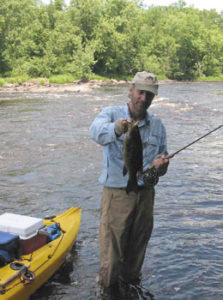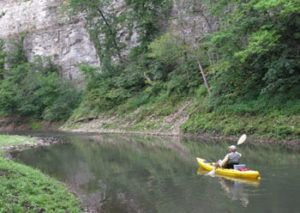In prime smallmouth bass hotspots, it’s often best to fish on foot, to thoroughly cover the area and cast to all the active smallies. Many anglers truly enjoy wade fishing, too, includng fly folks coming from stream trout backgrounds. But on bigger smallmouth streams, floating by watercraft is often the best way to really cover water. So what to do? That’s easy– do ’em both by employing the “Park and Wade” technique.
The concept is simple. You float several miles of stream by watercraft, parking it at prime locations to thoroughly wade-fish those spots. Sure, plenty of smallmouth anglers occasionally use some combination of floating and fishing on-foot. But most don’t really plan it out and hence do a poor job of it. So here are the A, B, Cs and a few of the X, Y, Zs of this effective fishing technique.
Why Wade?
Fishing on foot has several advantages. Foremost is casting ease. Fly casting while sitting is tough for most people, and being as low as you are in a standard kayak or canoe makes it really difficult. Then there is the issue of your loose line constantly catching and tangling on any and everything in the craft. Third is the problem of stability. Moving watercraft are rarely as stable as your feet planted firmly in the river bottom. And when two-person floating, getting out gives both of you plenty of elbow room, so no tangled lines and unpleasant verbal exchanges.
Why Float?
Floating also has major advantages. The primary one is the ability to cover a lot of water. Smallmouth eat higher on the food chain than trout, so their numbers are generally only one-third as many per acre as trout. On many waterways, even a good wader can only cover a mile or so of stream per outing. This means you’re only fishing over a relatively small number of catchable-size smallmouth. But expand that distance to 5, 6 or even 8 or 9 miles, and you can make contact with vastly more fish.

This stream has many riffles and runs–perfect for stopping to wade
By floating, you also can reach waters off-limits to walk-in anglers. Some streambeds are silty, others slippery, some have brushy banks or housing to the water’s edge, all of which makes reaching a lot of places impossible with just your feet. Yet another floating advantage I really appreciate is being able to haul a lot of stuff. The craft is the mule, not you. That’s sweet.
Floating Frustrations
But float fishing “ain’t all beer and skittles,” as my old uncle Joe used to say. You may be able to cover an ocean of water with a craft, but effectively fishing from the boat presents more problems than just tough casting. Craft control is difficult in rivers, even for us veteran river guides. For average fellas who only get on stream a few times each year, handling river current well enough to fish effectively is often mission impossible. Rigging a craft well enough to seriously fish from it is another thorny issue. Creating adequate casting room, good anchor systems, and good propulsion (oars, paddles or motors) for your boat isn’t easy.
Transportation Only
On the other hand, if you use your craft as transportation only, the problems I just mentioned seem to all magically disappear. For park-and-wade fishing, a basic kayak or canoe is fine. Kayaks nowadays are widely available, relatively inexpensive, very durable, easy to transport on top of your vehicle and easy to store on the garage wall or ceiling. Most importantly, since you aren’t trying to do much fishing out of your craft, you don’t have to be become an expert boat handler. Nor do you need to rig the craft with much beyond the bare minimum of a paddle, PFD and maybe a simple hand-thrown anchor.
Other types of small boats can also be used for Park-and-Wade fishing. The old reliable canoe is great (especially equipped with oars or a double bladed paddle). Another solo possibility is a small pontoon boat. However, ‘toons are slower than kayaks or tandem canoes, so your float distances may have to be shortened.
Planning Pays
Just “going with the flow” and stopping wherever and however long the spirit moves you is one way to use the park-and-wade method. However, you’ll catch a lot more fish, and you’ll enjoy the day a lot more, if you do a little planning and preparation. For larger and mid-sized rivers, the goal is to target a section with at least 6 to 8 major riffles, runs or boulder fields. A few more of these fish-holding (and wade-friendly) areas in the section you’re floating are fine, but don’t try to stop and fish more than dozen locations in a day.
If a river section is just 6 miles long, it will take you a minimum of 2 1/2 hours to travel that distance, and if each fishing stop averages 30 to 35 minutes, hitting a dozen hotspots will add up to a full day. On smaller streams, many pools will be small and shallow enough to be easily fished on foot. And if the stream is really small, your targets may only take 15 or 20 minutes to thoroughly fish. Therefore, having a few more likely locations, perhaps 20, available for the day is a good idea.

A kayak is a good craft to float down a very small stream
Finding Park-and Wade Water
If you don’t already know of any streams that fit these criteria, detailed maps can help you find them. Canoe guides and other river maps often show riffles, rapids and boulder fields– all obvious hotspots. Maps available from the Internet using photo imagery are becoming increasingly detailed and can also be used to identify river features. And when you do ultimately hit the river, be sure to take notes. A notebook and pencil is okay, but a small voice recorder makes it super-easy. Naturally, you can record all sort of details about a trip, but you should at least note how many good wading locations you found and about how far apart they are. A GPS unit can allow you to measure exact distances, but I find my estimates of “about 600 yards,” “a little less than a mile,” etc. to be sufficient.
Pacing Makes Perfect
This happens all too often: Guys spend hours pounding the first couple of good spots, or stop to fling casts at every eddy in the river over six inches deep, and end up having to give short shrift to all the other good spots because it’s late and they need to get off the river before dark. You can avoid this mistake by pacing yourself. So exercise angling discipline and know how long to stop and when it’s time to move on. On most lower-gradient rivers, two guys paddling hard in a canoe can barely cover 3 miles in an hour. If there are head winds or shallows to drag through, travel will be considerably slower. So leave those 15-mile floats for the guys who don’t intend to fish. And when you aren’t fishing, grab the paddle and really dig in.
One More Tip
When approaching a fishing spot, be careful not to alarm the fish. Sometimes that means quietly parking the boat well upstream of the target and approaching on-foot. Other places, it may mean sneaking the craft around the spot on the shallow side of the river and wading back upstream to fish it. And if there are two of you, rotate who gets first crack at the very best spots. Almost nothing spoils a trip more than a selfish or inconsiderate fishing partner.
Of course, not every stretch of river is conducive to the “park and wade” technique, and certainly not everyone will want to fish in this manner all the time. But in many situations, I think it’s an excellent way to pursue the mighty smallmouth. You can have your wading and float the river, too. And what’s wrong with that?


No comments yet.